by Taylor Vandiver | Oct 7, 2014
I think it’s safe to say fall is officially here. Shouts can be heard from local football stadiums, occasionally a crisp fall breeze will send us looking for a light jacket, and coffee shops are pushing all things pumpkin. Now that we can officially appreciate the cooler fall weather, it may be time to stretch our legs and marvel at the spectacular show of color our landscapes are putting on. Here are a few plants that are showing off this time of year.
Firebush (Hamelia patens) – This charming Florida native will delight everyone with beautiful orange-red flowers throughout most of the year. Hummingbirds and butterflies enjoy the nectar in the flowers. Firebush can reach a height and width of 8 to 12 feet. It is a fast growing plant that will grow well in part to full sun environments.
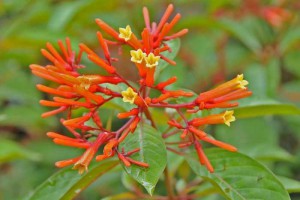
Bright orange-red blooms on a firebush. Photo courtesy UF/IFAS.
Salvia (Salvia spp.) – Salvias are great plants for bringing butterflies and hummingbirds to your garden and as a bonus, they have no serious pests. With hundreds of annual and perennial species coming in an array of colors and sizes, you can easily find one or more to complement your landscape. Salvias perform best in full sun environments and are considered drought tolerant.
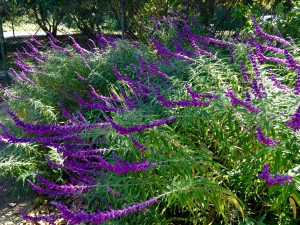
Deep purple blooms on a salvia in the landscape. Photo courtesy Taylor Vandiver.
Turk’s Cap (Malvaviscus arboreus) – Turk’s cap can add a cheerful pop of color at a time when little else is blooming. This old-fashioned Florida-Friendly shrub like perennial is related to the hibiscus. It’s known for its bright red flowers that always seem ready to open, but never do. Turk’s cap starts blooming in summer and keeps going until through winter, unless hit by a hard frost. It can grow in full sun and reach up to ten feet tall and ten feet wide, so give it room to grow. This easy-care native perennial requires little maintenance once it’s established.
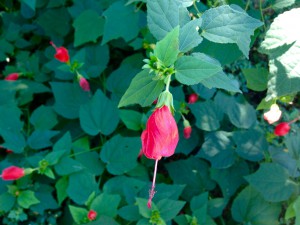
Turk’s cap showing off its unique blooms. Photo courtesy Taylor Vandiver
Coleus (Solenostemon scutellarioides) – When imagining fall color we often don’t consider coleus. However, the vibrant foliage can add interest to any landscape throughout the fall. Coleus is prized for its colorful foliage, which comes in shades of green, yellow, pink, red, and maroon. Coleus varieties can range from one to several feet in height. They can be used in hanging baskets, containers on patios, or in landscape beds. Coleus prefers partial shade and you can pinch the growing stems of young plants frequently to encourage dense foliage. Keep an eye out for mealybugs on coleus and use insecticidal soap if problems develop
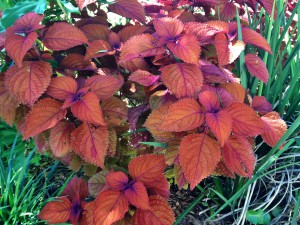
Burnt orange foliage standing out amongst the neutral green of the landscape. Photo courtesy Taylor Vandiver.
Fore more information contact your local extension agent. Also you can visit us at gardeningsolutions.ifas.ufl.edu or edis.ifas.ufl.edu.
by Taylor Vandiver | Nov 11, 2013
As I made a visit back to my hometown in North Alabama I was reminded of the subtle changes from fall into winter, which are not always apparent to me living in Tallahassee: the vibrant palette of leaves as they make their permanent descent until spring, the litter of spent cotton along each highway and county road and the annual pecan harvest that has been a tradition in my family for as long as I can remember.
Due to the variations in climate and topography from upper Alabama to the panhandle of Florida, our seasons can differ greatly. However, I know of one entity that remains a constant and that is the availability of pecans. Pecan trees (Carya illinoinensis) are a common sight throughout the South. They can be spotted as far west as Texas and as far north as Illinois. The pecan tree is native to the Mississippi floodplain, which has deep, fertile, well-drained soils. Before the arrival of Europeans, Native Americans used pecans as a primary food source for thousands of years.
What’s more, pecans have major economic value. The annual value of pecans in the United States is estimated at 200 to 500 million dollars. Florida produces from five to ten million pounds of pecans annually. The majority of that pecan production acreage (6,500 acres) can be found in North Florida. While the nut is the main attractant of the tree, there’s not much that warms the heart more than seeing pecan pie at the dessert table on Thanksgiving.
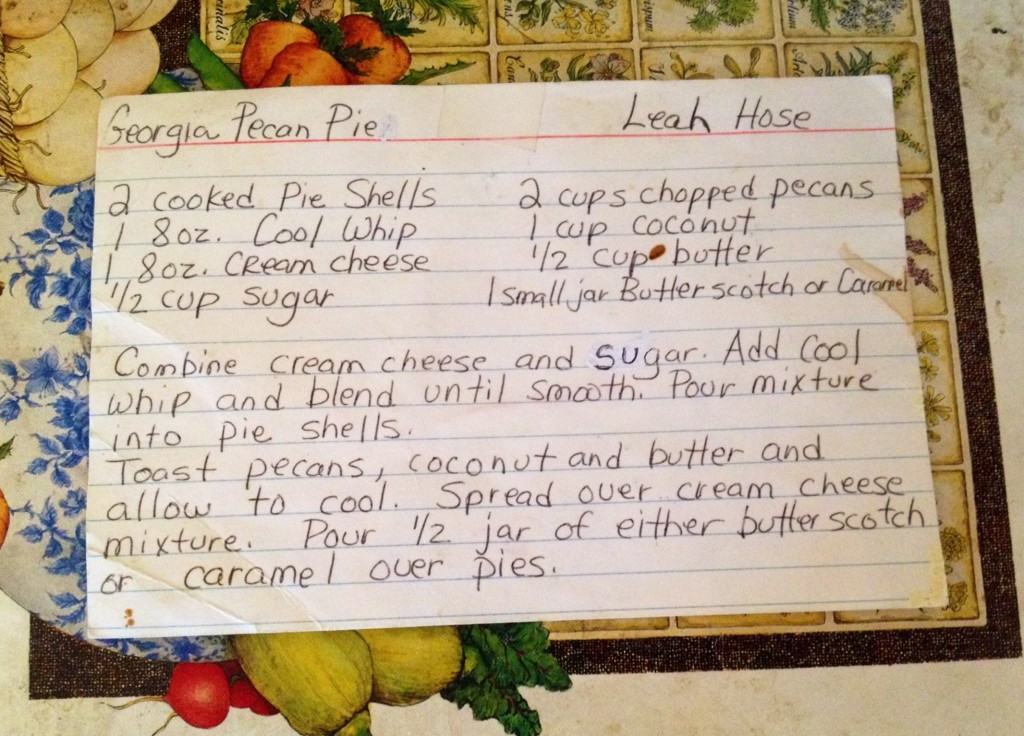
A well worn recipe for southern pecan pie that has been passed down through my family.
Pecan trees are deciduous, which means that they drop their leaves in the winter. An additional consideration for those planning to install pecan trees is to be aware that they are wind-pollinated and that their male and female flowers often do not mature at the same time. Therefore, in order to ensure the possibility of high yields, two or more cultivars should be planted together for cross-pollination.
Be sure to choose a variety like ‘Elliot’ or ‘Curtis’ that has good disease resistance, is suited for North Florida and will cross-pollinate well. Plant pecans during the colder months to allow for root growth before spring. The optimum soil pH for pecans is 5.5 to 6.5. At the lower end of this range, micronutrient deficiency symptoms should be less common. Pecan trees should start producing decent crops in six to twelve years. A tree at maturity can reach up to seventy feet tall so plan spacing and placement accordingly.
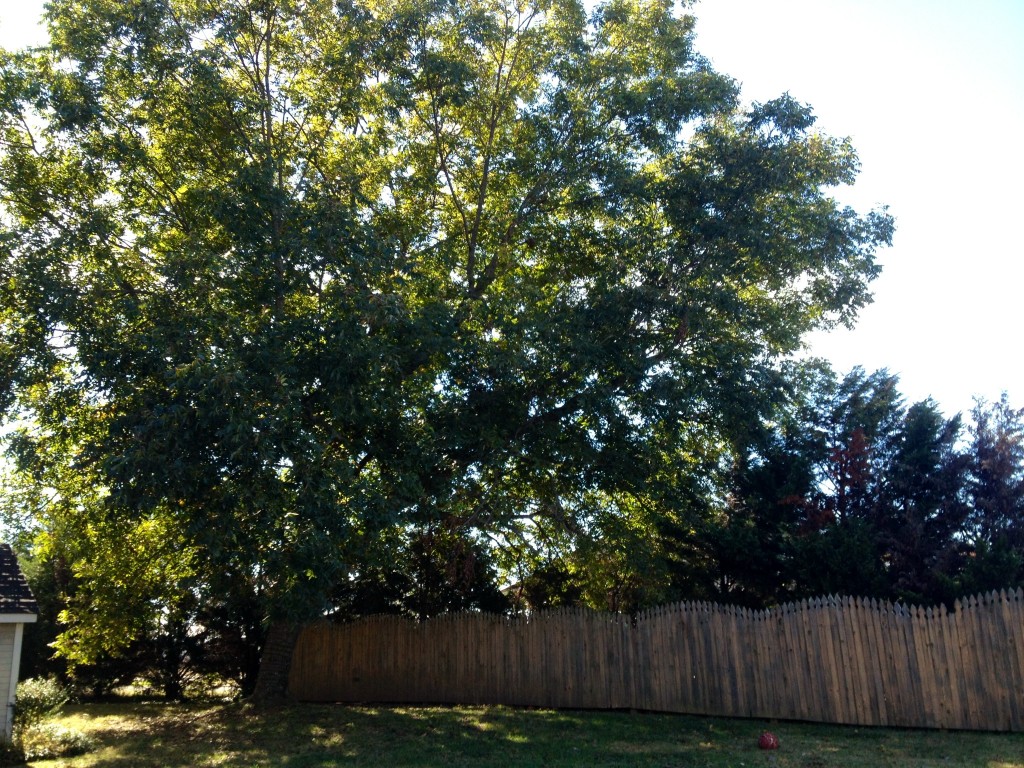
Pecan tree planted by my great-grandparents in Monrovia, Alabama.
For more information please consult Pecan Cultivars for North Florida or contact your local UF IFAS county extension office.






